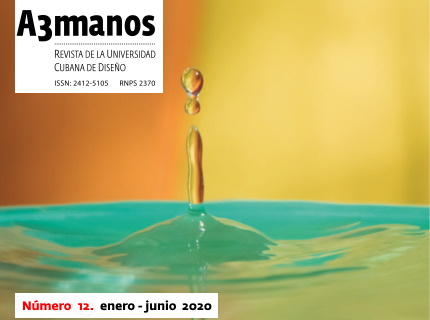Usability as ergonomic property
##plugins.themes.bootstrap3.article.main##
Abstract
Although the subject of Usability has been addressed previously, it is always linked to the evaluation of digital interfaces, never to industrial design objects. Consequently, it is decided to analyze the different theoretical approaches on Usability, in the search for elements that allow to determine if this concept can also be applied to industrial design objects. In this article, authors' models that include usability as part of their theories are exposed, for their selection, the relevance and significance of their work in the field of web usability was taken into account, some of them being fundamental pillars on the that are based most of the studies on the subject. After analyzing the concepts of Usability issued, it could be concluded that, although they have points in common, there is no consensus opinion that defines the term, since each author relates it to its specific field of study. Based on these conclusions, a concept of Usability consistent with the design of objects was defined, based on the link between the main elements proposed and the objectives of Ergonomics.
##plugins.themes.bootstrap3.article.details##

This work is licensed under a Creative Commons Attribution-NonCommercial-ShareAlike 4.0 International License.
- Attribution — You must give appropriate credit , provide a link to the license, and indicate if changes were made . You may do so in any reasonable manner, but not in any way that suggests the licensor endorses you or your use.
- NonCommercial — You may not use the material for commercial purposes .
- No additional restrictions — You may not apply legal terms or technological measures that legally restrict others from doing anything the license permits.
- ShareAlike — If you remix, transform, or build upon the material, you must distribute your contribution under the same license as the original. NOTE: This point applies to numbers 1 to 20 of the magazine with the previous CC-BY-NC-SA 4.0 license. Does not apply to the new CC BY-NC 4.0 license from Volume 11, Number. 21 (2024).
References
Ángela María Huelves Sarco, F. A. (2009). Diseño para la usabilidad de productos. Técnica Industrial, 47-53.
Cockton, G. (s.f.). The Encyclopedia of Human-Computer Interaction, 2nd Ed. Usability Evaluation. Obtenido de Interaction Design Foundation.
Fernández, Y. H. (7 de septiembre de 2005). La Experiencia del Usuario. Obtenido de No solo usabilidad: http://nosolousabilidad.com/index.htm
Gordillo, C. (2011). “Herramientas para el tratamiento del factor uso con intervención de la Ergonomía durante el Proceso de Diseño”. Tesis de Maestría. La Habana.
Interaction Design Foundation. (2002). Interaction Design Foundation. Obtenido de https://www.interaction-design.org
Interaction Design Foundation. (2002). User Centerd Design. Obtenido de Interaction Design Foundation: https://www.interaction-design.org
Knapp Bjerén, A. (2003). La Experiencia del Usuario. Madrid: Anaya Multimedia.
Krug, S. (2006). No me hagas pensar. Una aproximación a la usabilidad Web. (segunda edición ed.). Madrid: Pearson Educación,S.A.
Mary Beth Rosson, J. M. (2002). Usability Engineering. Scenario-based development of human-computer intraction. Estados Unidos de América: Morgan Kaukmann Publishers.
Mathis, L. (2011). Design for Use. USA: Pragmatic Books.
Morville, P. (21 de Junio de 2004). User Experience Design. Obtenido de Semantic Studios: http://semanticstudios.com/user_experience_design/
Nielsen, J. (1993). Usability Engineering. Academic Press.
Nielsen, J. (2000). Usabilidad. Diseño de sitios Web. Madrid: Pearson Education.
Nielsen, J. (4 de enero de 2012). Nielsen Norman Group. Obtenido de Usability 101: Introduction to Usability: https://www.nngroup.com
Nielsen, J. (4 de enero de 2012). Usability 101: Introduction to Usability. Obtenido de Nielsen Norman Group: https://www.nngroup.com
Norman, D. (1988). La psicología de los objetos cotidianos. New York: Basic Books.
Organización Internacional de Normalización. (1991). ISO/IEC 9126: 1991 Ingeniería de software - calidad del producto. Ratificada el 1 de diciembre de 2011.
Organización Internacional de Normalización. (1999). ISO 13407:1999 – Proceso de Diseño Centrado en el Humano para sistemas interactivos.
Organización Internacional de Normalización. (2001). ISO/IEC 9126-1:2001 Ingeniería del software - Calidad del producto - Parte 1: Modelo de calidad. Ratificada el 1 de diciembre de 2011.
Organización Internacional de Normalización. (2004). ISO/IEC TR 9126-4:2004 Ingeniería de software - Calidad del producto - Parte 4: Calidad en las mediciones de uso. Ratificada el 1 de diciembre de 2011.
Organización Internacional de Normalización. (2011). ISO/IEC 25010 Ingeniería de sistemas y software - Sistemas y software Requisitos y evaluación de calidad (SQuaRE) - Modelos de calidad de sistemas y software. https://www.iso.org/standard/35733.html: Ratificada en 2017.
Organización Internacional de Normalización. (03 de 2018). ISO 9241-11: 2018 Ergonomía para la interacción hombre-sistema. Part 11: Usabilidad: Definiciones y conceptos. Obtenido de https://www.iso.org/obp/ui/es/#iso:std:iso:9241:-11:ed-2:v1:en
Prado León, L. R., & Ávila Chaurand, R. (2006). Ergonomía y diseño de espacios habitables: factores antropométricos y socioculturales. Guadalajara, México: Centro Universitario de Arte, Arquitectura y Diseño. Universidad de Guadalajara.
Santamaría, Y. H. (2009). Informe APEI sobre usabilidad. Gijón: Asociación Profesional de Especialistas en la Información.
Shackel, B. (1991). Usability–context, framework, definition, design and evaluation. En B. Shackel, Human factors for informatics usabililty. Cambridge: University Press.
Shneiderman, B. P. (2016). Designing the User Interface: Strategies for Effective Human-Computer Interaction (sexta edición ed.). Pearson. Obtenido de http://www.cs.umd.edu/hcil/DTUI6






















